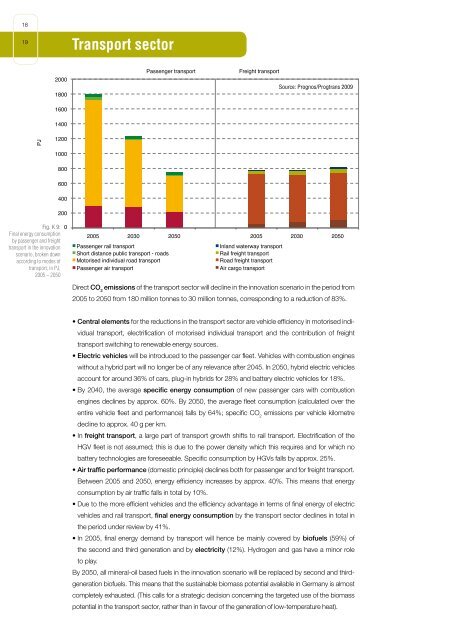Blueprint Germany - Öko-Institut eV
Blueprint Germany - Öko-Institut eV
Blueprint Germany - Öko-Institut eV
Create successful ePaper yourself
Turn your PDF publications into a flip-book with our unique Google optimized e-Paper software.
18<br />
19<br />
PJ<br />
2000<br />
1800<br />
1600<br />
1400<br />
1200<br />
1000<br />
Fig. K 9:<br />
Final energy consumption<br />
by passenger and freight<br />
transport in the innovation<br />
scenario, broken down<br />
according to modes of<br />
transport, in PJ,<br />
2005 – 2050<br />
800<br />
600<br />
400<br />
200<br />
0<br />
Transport sector<br />
Passenger rail transport Inland waterway transport<br />
Short distance public transport - roads<br />
Motorised individual Bruttoinlandsprodukt road transport<br />
Rail freight transport<br />
Road freight transport Bevölkerung<br />
Passenger air transport Air cargo transport<br />
Direct CO emissions of the transport sector will decline in the innovation scenario in the period from<br />
2<br />
2005 to 2050 from 180 million tonnes to 30 million tonnes, corresponding to a reduction of 83%.<br />
• Central elements for the reductions in the transport sector are vehicle efficiency in motorised individual<br />
transport, electrification of motorised individual transport and the contribution of freight<br />
transport switching to renewable energy sources.<br />
• Electric vehicles will be introduced to the passenger car fleet. Vehicles with combustion engines<br />
without a hybrid part will no longer be of any relevance after 2045. In 2050, hybrid electric vehicles<br />
account for around 36% of cars, plug-in hybrids for 28% and battery electric vehicles for 18%.<br />
• By 2040, the average specific energy consumption of new passenger cars with combustion<br />
engines declines by approx. 60%. By 2050, the average fleet consumption (calculated over the<br />
entire vehicle fleet and performance) falls by 64%; specific CO emissions per vehicle kilometre<br />
2<br />
decline to approx. 40 g per km.<br />
• In freight transport, a large part of transport growth shifts to rail transport. Electrification of the<br />
HGV fleet is not assumed; this is due to the power density which this requires and for which no<br />
battery technologies are foreseeable. Specific consumption by HGVs falls by approx. 25%.<br />
• Air traffic performance (domestic principle) declines both for passenger and for freight transport.<br />
Between 2005 and 2050, energy efficiency increases by approx. 40%. This means that energy<br />
consumption by air traffic falls in total by 10%.<br />
• Due to the more efficient vehicles and the efficiency advantage in terms of final energy of electric<br />
vehicles and rail transport, final energy consumption by the transport sector declines in total in<br />
the period under review by 41%.<br />
• In 2005, final energy demand by transport will hence be mainly covered by biofuels (59%) of<br />
the second and third generation and by electricity (12%). Hydrogen and gas have a minor role<br />
to play.<br />
Passenger transport Freight transport<br />
Source: Prognos/Progtrans 2009<br />
2005 2030 2050 2005 2030 2050<br />
By 2050, all mineral-oil based fuels in the innovation scenario will be replaced by second and thirdgeneration<br />
biofuels. This means that the sustainable biomass potential available in <strong>Germany</strong> is almost<br />
completely exhausted. (This calls for a strategic decision concerning the targeted use of the biomass<br />
potential in the transport sector, rather than in favour of the generation of low-temperature heat).

















